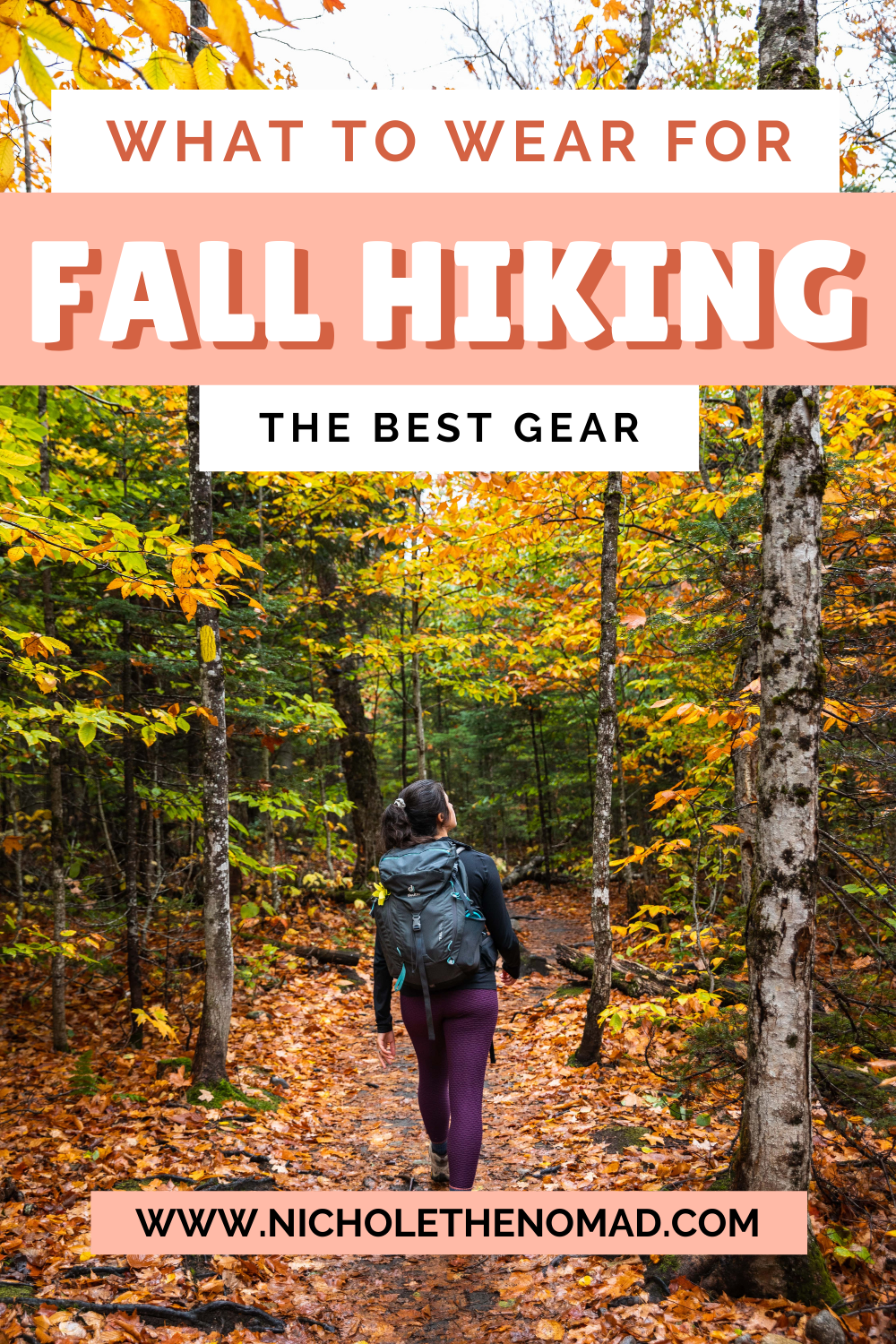What to Wear Hiking in Fall
Fall is one of the best times to hike, in my opinion, because the foliage is stunning, and the weather is beautiful! But fall can have unpredictable weather, making it crucial to understand what to wear hiking in fall.
I have hiked plenty of times in the fall where the trailhead temperatures were significantly warmer than the summits, and sometimes the summits have snow! Layering is important when hiking in fall to keep you warm.
This guide will review everything you need to know about what to wear hiking in fall, so you feel confident on the trail!
Disclaimer: This post contains affiliate links. If you click through and make a purchase, my blog may receive a commission at no additional cost to you.
Tips for Hiking in Fall
Fall is one of my favorite times to hike as the weather cools down and the leaves begin to change. But it is important to remember that winter can come early in the mountains, so we have to prepare for any condition we may find on the trail.
Important Things to Know
Layers are crucial. Winter conditions can arrive early in the mountains, and having the appropriate layers to keep you warm and dry is crucial! The typical layering system consists a base layer that wicks moisture, a mid-layer that insulates you, and an outer shell that is windproof and waterproof. Although I may not need all of these layers on a fall hike, I always pack them just in case the weather changes.
Check the weather before you hike. Since the fall weather can range from warm summer temperatures to whiteout conditions, it is crucial to check the weather before you leave for your hike. Checking the weather allows you to reevaluate the gear you packed or if you might want to move your hike to a different day.
Don’t be afraid to turn around. It is crucial to listen to our bodies and pay attention to the weather and conditions around us while we hike. Do not be afraid to turn around for any reason. It is better to be safe!
Always pack the Ten Essentials. You should always always always pack the Ten Essentials on every hike, no matter the difficulty or length.
What to Wear Hiking in Fall
One of the most important things for learning what to wear hiking in fall is layering. Having multiple layers allows you to add them when you are cold or remove them as your body temperature rises. Even if you do not wear all of your layers, it is important to pack them just in case!
Fall Hiking Footwear
Usually I start packing my microspikes in the fall because New Hampshire mountains can have winter conditions early. I like to have them just in case!
- Hiking boots: Because the weather is unpredictable in fall, I recommend getting waterproof hiking boots that are supportive, comfortable, and durable. If your feet run cold or as we get closer to winter, I recommend getting insulated hiking boots to help keep your feet warm.
- Wool socks: Hiking socks are just as important as other fall hiking gear because they keep your feet warm and dry. The best types of socks to wear are ones made of wool because they retain heat while wicking moisture.
- Microspikes: Microspikes are important to pack because the cooler temperatures can bring icy and snowy trails. These will provide you with traction to keep you steady and safe while hiking. They are also lightweight and easy to pack in their storage bag when you are not using them.
Fall hiking Base Layers
Your base layers will help regulate your body temperature and wick moisture. How warm your base layers are depends on the temperatures you are hiking in. At the beginning of fall, I tend to wear lightweight leggings and a short-sleeve shirt, but as we get closer to winter, I wear longer-sleeved shirts and thicker leggings.
Fleece-lined leggings: As the weather gets colder in fall, you will want to wear thicker or fleece-lined leggings to keep your legs warm. These leggings are perfect fall hiking because they are warm, breathable, and moisture-wicking. They also have stretchy fabric, so you can move freely on the trail while staying warm.
Short-sleeve shirt: A short-sleeve shirt is the perfect top base layer when it is warm. The shirt will help regulate your body temperature and wick moisture as you hike.
Long-sleeve shirt: A long-sleeve shirt is great as a base layer when it starts to get colder. This base layer should be lightweight, moisture-wicking, stretchy, and breathable, giving you the ultimate comfort on the trail.
Fall Hiking Insulating Layers
Because weather in fall can be unpredictable in the mountains and winter conditions can arrive early, I always pack insulating layers just in case.
- Fleece jacket: Fleece jackets are warm, breathable, and retain your body heat, making it a great layer to wear on top of your base layers. Because fleece jackets do not tend to be waterproof, you will need an outer layer to protect you from the elements.
- Down jacket: Down and synthetic jackets are crucial insulating layers that retain your body heat. Down jackets are warm, lightweight, and compressible but lose efficiency when it gets wet. Synthetic jackets are similar and perform better when wet but do not compress well. Both are great insulating layers!
- Weatherproof jacket: An outer shell jacket protects you from the elements, including rain and wind. Most rain jackets make perfect outer shell jackets because they are waterproof and windproof.
Fall Hiking Accessories
The extra hiking accessories you bring on a fall hike depends on the weather. As winter conditions arrive in the mountains, I pack more winter hiking gear.
- Daypack: Of course, one of the most important pieces of hiking gear is a daypack. Because you will be packing layers, I recommend getting a bag that can fit everything you need, including gear, food, and water.
- Neck gaiter: Many people overlook the importance of having a neck gaiter or something to keep your neck, nose, and cheeks warm. A neck gaiter helps keep your neck warm while you hike in fall, and you can pull it over your cheeks and nose when they get cold.
- Hat: Most of our body heat escapes through our heads, so having a warm hat will help insulate your head to retain body heat.
- Gloves: Your hands should not be left out when keeping your body warm because they tend to be the first parts of our bodies to get cold. I recommend getting a warm base layer gloves and a waterproof pair.
Remember, it is better to have more layers that you do not need than not enough. This guide is a great starting point to learn what to wear hiking in fall!
Hey, I’m Nichole!
I am the creator behind Nichole the Nomad, the home of my explorations around the world, mountain hikes, and beautiful pictures taken along the way. I have a deep passion for capturing the world in a beautiful light and sharing my experiences.
I created this blog to share my travels, show how beautiful the world is, provide tips and tricks for traveling, and encourage you to explore. Whether you want to travel across the world or explore what’s in your backyard, I hope this blog inspires you to get outside and find your adventure!
Pin it for later!










